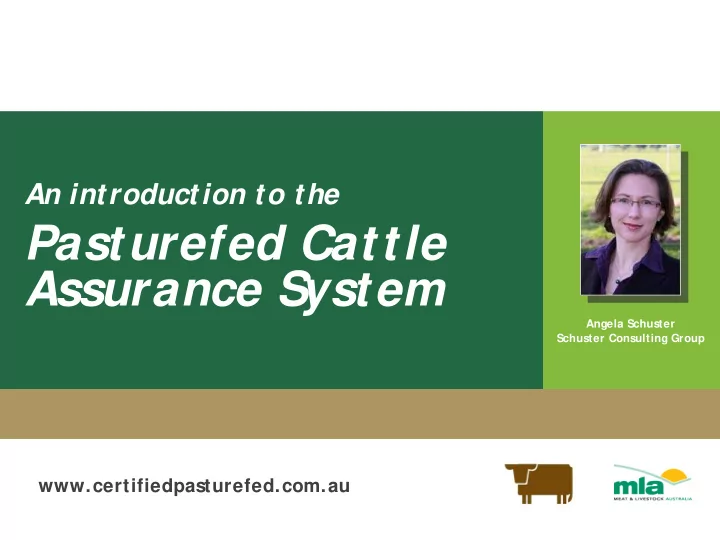

An introduction to the Pasturefed Cattle Assurance System Angela Schuster Schuster Consulting Group www.certifiedpasturefed.com.au
Agenda What is PCAS and why Certified Pasturefed? The PCAS S tandards Gaining and maintaining Certification Q&A Resources to assist The pathway to Certification Q&A Meeting the PCAS S tandards
What is PCAS? Pasturefed Cattle Assurance System An initiative of the Cattle Council of Australia. Supported by Meat & Livestock Australia. Developed with industry consultation. Certifies pasturefed production method claims. Voluntary – adoption is a business decision.
What is PCAS? An animal raising claim – cattle: – Have only been fed pasture their entire lives; – Have not been confined for intensive feeding for production; – Have been handled consistent ly with MS A requirements; – Are free from hormone growth promotants (HGPs); and/ or – Are free from antibiotics. – Lifetime traceability proves eligibility.
Why Certified Pasturefed? Market demand. Consumers require verifiable assurances. Label claim validation. US DA and AGA requirements.
Verifying raising claims Angus – verified by physical characteristics. 100 days grain fed – verified by dates in and out. HGP-free – verified by palpation. Never ever been feed grain – verified by ? Never ever been confinement fed – verified by ? Never ever been treated with antibiotics – verified by ?
The PCAS Standards S tandards and Rules provide requirements. Compliance demonstrated with third-party annual audits. Independent audits provide integrity. Verifiable evidence gives assurance. Compliance results in Certification: “ This product is as claimed”
Certified Pasturefed Marks
Steps to gaining Certification Visit www.certifiedpasturefed.com.au Read the S tandards, documents, checklists and guides. Register your property online. Arrange an on-site audit. Have records and documents ready for the audit.
Maintaining Certification An on-site audit is required every year. You must keep records and evidence for the 12 months between each audit.
What does it cost? Annual administration fee: $200. Annual audit costs: Based on complexity and location. Typical range is between $400 and $800 (could be more). Travel costs are over and above audit cost. Travel costs can be reduced through “ milk-runs” . (all prices excluding GS T)
Resources to assist www.certifiedpasturefed.com.au PCAS S tandards and Rules PCAS Producer Guide and Example Templates PCAS Audit Checklist Online S elf-audit Usage Guidelines for the Marks
Questions? Type your questions here anytime www.certifiedpasturefed.com.au
The pathway to Certification
Prepare for the audit Read the S tandards, checklists and guides. Assess your own property against these documents. Complete the Pre-Audit Application Form. Contact either or both PCAS Certification Bodies. Provide them with the Pre-Audit Application Form. They will provide a quote for audit.
On the day of the audit Make sure the person responsible for the following is on- site for the audit: – The management of the cattle. – The record keeping and management. Have a property map available. The auditor will want to see features on your property. Have appropriate records in an auditable format.
Understanding audit outcomes Demonst rat ed compliance is required for Certification. There is no pass or fail. The auditor may identify areas that need attention. Take appropriate action to rectify non-conformances. S ubmit evidence of actions taken. Evidence can include a “ close-out” plan.
First Certified Pasturefed producer: Ross Rolfe (L) with Greg Hardgrave (C) and Jed Mat z (R)
Meeting the PCAS Standards Element 1: Identification and Lifetime Traceability Outcome: On-farm systems have been implemented to ensure that cattle are individually identified and that they retain a Lifetime Traceable (LT) status on the National Livestock Identification System (NLIS) Database. Cattle must be identifiable and traceable throughout their entire life from birth (weaning) to slaughter.
Meeting the PCAS Standards Element 2: No Confinement for the Purpose of Intensive Feeding for Production Outcome: On-farm systems have been implemented to ensure that cattle are not confined for the purpose of intensive feeding for production. Cattle cannot be confined.
Meeting the PCAS Standards Element 3: Pasturefed Only Outcome: On-farm systems have been implemented to ensure that cattle have never been fed separated grain or grain by- products and have access to graze pasture with an Eligible Diet. Cattle can be fed a range of items and supplements but not cereal grain.
Meeting the PCAS Standards Element 4: Minimum Eating Quality S tandards (On-farm) Outcome: On-farm systems have been implemented to ensure that cattle consigned to slaughter are eligible to be accompanied by a Meat S tandards Australia (MS A) Vendor Declaration. MSA specifications set by processor.
Meeting the PCAS Standards Element 5 (optional): Lifetime Free from Hormonal Growth Promotants Outcome: On-farm systems have been implemented to ensure that cattle have never been treated with hormonal growth promotants (HGPs). Never ever treated with HGPs.
Meeting the PCAS Standards Element 6 (optional): Lifetime Free from Antibiotics Outcome: On-farm systems have been implemented to ensure that cattle have never been treated with antibiotics including; low-level (sub-therapeutic) or therapeutic level doses; sulphonamides, ionophores, coccidiostats; or any other synthetic antimicrobials. “Treatment” by Injection or ingestion.
Summary A program for certifying production methods. A program to provide customer assurances. Conformance to S tandards is required for certification. Integrity through third-party annual on-site audits. On-farm records and practices key. Online resource: www.certifiedpasturefed.com.au
Questions? Type your questions here anytime www.certifiedpasturefed.com.au
Recommend
More recommend